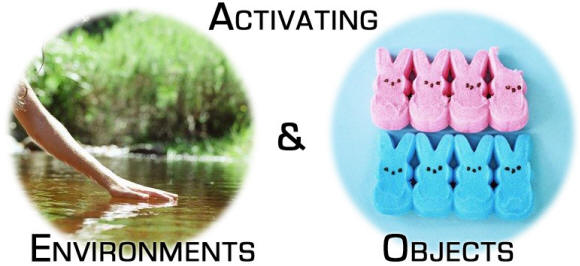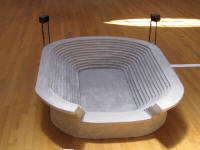
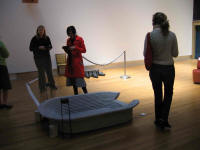
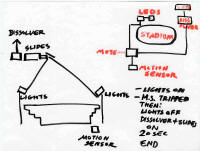
stadium
Ella Gilboa and Rotem Linial
Media: Installation
Size: 6' x 4' x 2' (floor bound)
Description
The piece put together for this class is a
part of a show displayed at the SFAI Diego Gallery on may 10th. This
sculpture piece is a stadium assembled from Styrofoam board plates
covered with joint compound, textured to appear like it is concrete
built.
Our goal was to make a diorama of a stadium where allegedly an event
occurred. This is accomplished by sound of a crowd cheering and a
mote generating lights and a projector. When the viewer approaches
the piece a motion sensor triggers a relay connected to a mote
telling it to close the lights and turn on the projector. The
projector displays abstracted diagrams slides constructed of
universal symbols (arrow, circle, X etc’) alluding to a narrative or
an historic occurs.
This piece is one of several in this show. Our interest was to
explore ways of displaying art and to find the ultimate “hook” for
the viewer to the art piece. We put together a kind of an audio tour
that functions as a soundtrack for the show as well as an experience
that the viewers can share individually. The show’s narrative is of
a secret society that has it’s own made up history. We chose to
display it’s made up residues like a coat of arms, decorative
ceramic plates as well as dioramas like the stadium itself and a
small façade of a town that looks like a movie set.
We attempted to create a space that is not conventionally
interactive but which engages the viewers through the use of tools
of display and museum-like aesthetics.
Technical Details
We hooked up a slide projector to a dissolver
that controls the projectors lamp. A few LEDs (functioning as
stadium lights) are hooked up to a relay. A motion sensor trips a
relay. A mote connected to the relay senses whether the relay was
tripped or not. When it is triggered the mote trips the second
relay, which turns the dissolver on, and the LEDs off. The projector
is controlled by it’s own internal timer, the dissolver only turns
the lamp on and off. The projector project slides for 10 seconds and
turns off. This occurs only in relation to the motion sensor.
Otherwise the stadium functions as a static sculptural piece.
Mote code used in project
TBA
Links
http://www.nps.gov/alcatraz/
http://www.worldstadiums.com/
|
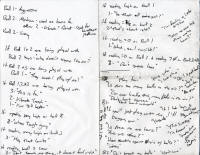
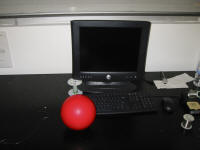
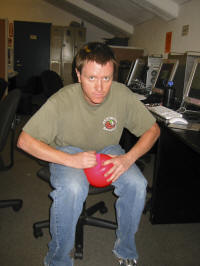
Fractions of Who I Am
Brian Mills
Media: Foam Balls and Motes
Size: 7.5” Diameter Each
Description
The balls are part of a playfulness that
exists within me, the inner child one might say. I have integrated
three voices into the existence of the balls one of which being my
own voice. The other two are by women who are significant parts of
my life in differing manners. I had the women use their own
personalities to develop the sayings for each ball so while the ball
could be considered to have the personality of the woman, I feel
that their personalities are versions of me as well. I think of
myself in thirds. It is also significant that I used the voices of
females as I have often felt that two-thirds of me is female and one
third is male.
I have always had many female friends (many
more than male friends) and a few years ago, as I was preparing
breakfast for a friend and myself she said, “You’ll make a great
wife to a lucky woman some day.” I have reflected back on that and
feel that was an accurate observation as I have assumed many of the
duties that were once said to be those of a house-wife.
The women who I picked cover ends of a
spectrum that I only enter occasionally. I am generally
mild-mannered, but there are times when I can be very aggressive.
Other times, at the other end of the spectrum, I can be extremely
meek. The women who I selected cover those ends as I think of myself
as generally in the middle of the continuum.
Technical Details
They are rather simple in a way as the balls
include with the Mote, an accelerometer that when jostled to a
certain level will react with different pre-recorded voice files
depending on which level the reading comes in at.
Mote code used in project
TBA
Links
http://www.python.org/
|
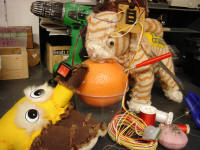
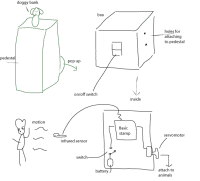
Puppy Poppy Poopy
Hikaru Furuhashi
Media: Sculpture
Size: About 1
yard by half yard
Description
Through this art piece, puppy poppy poopy,
I want people to be surprised and shocked. I was interested in
playing with people’s expectation towards display of art.
I am going to have a pedestal, about a yard tall, them I put a dummy
doggy bank sculpture made of cheap ceramic made by an elementary
school student on the pedestal. (I purchased at GoodWill store for
$1.99) I’ll stick a white label which has my name, medium, and dates
on the side of pedestal like regular way of installing and showing
the small sculpture. So that people will think the doggy bank is my
actual art piece. However, here is a trick. There is a secret on the
back of pedestal. I’ll have a box which Basic Stamp and other
components in it, and a stick is attached to the box. On the
opposite side of stick, there is a very strange animals attached.
And the sensor detects when the audience approaches to the pedestal,
and Basic Stamp will pop up the strange animals from the side of
pedestal. People will see it from the position they are standing.
Then, people will be surprised and shocked as I intended.
The audience often carries some kind of expectation towards art
pieces when they go to see art exhibition to galleries or art
museums. However it is questionable that why people often behave
that way. I believe that the viewing and showing relationship should
be more free and open to any unexpectations and surprises.
Technical Details
The pedestal is made of wood, and painted to
white. The doggy bank is on the top of pedestal. There is a box
attached in the back of pedestal. In the box, there are Basic Stamp,
servomotor, batteries, and cables. The outside of the box, there is
a switch turns on and off. Also the infrared sensor is attached to
Basic Stamp through cables. The animal sculptures is attached to the
stick that is connected to the servomotor, And infrared sensor is
attached to the floor. The cables are going to be tape down in order
to be hidden and safety for the audience. When the infrared sensor
detects people come closer to the pedestal, the Basic Stamp will
“bang” the servomotor to tilt about 90 degree. Then, the animal
sculpture will pop up from the side of the pedestal. Basically, this
is very simple mechanism, but effectively make the audience
surprised. The technology of crafting the sculptures is low-tech,
all the sculpture are made of old stuffed animals and some of were
crochet. And every part was hand sewn.
Mote code used in project
TBA
Links
http://www.parallax.com/
(Basic Stamp)
|
|
Two Ways of Interpreting Time
Robert B. Santee
Media: video, accelerometer, max/msp and
jitter
Size: NTSC
Description
The goal of this piece was to examine the
relationship between movement (rate of acceleration/de-acceleration)
to standard time over the course of a twenty-four hour period.
Technical Details
A video camera and an accelerometer recorded
my movements over the course of a day. That information was fed into
a Max patch and the output is an image with two graphs below it. One
graph represents standard time, and the other represents the
frequency of the accelerometer readings arranged from high values to
low values. As you scroll over the graphs, the corresponding image
appears on the screen.
Mote code used in project
TBA
Links
www.cycling74.com
|
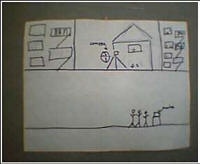
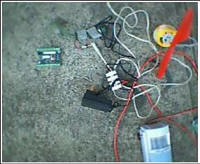
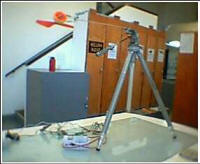
I Spy
Andrew Woon
Media: Video
Size: 5x3
Description
My project exploring the voyeuristic nature of
people, that seem to be the trend with all the reality TV show that
are out there. They seem to be controlling of our live and we can
not do anything about. Therefore I am proposing a project that will
do the same, so that the incontrollable urgings that we have as
observers people and their lives exploited. In My project the viewer
would be drowned in by images on a TV monitor that was installed.
The monitor would have a live feed room for a camera that was in a
remote place [on top of a building]. The images will be of people
window that live in the vicinity. The interesting thing about the TV
installation is that when someone approaches it the angle of the
video will change in a random fashion. This changes the image that
is initially seen by the viewer and gets their attention. By doing
this I will create a tension between the viewer and the monitor that
is install in the room because the viewer will fell that they do not
have full control of what they are watching. The goal of this
project is to keep the viewer consumed with the images that they see
even though they may no be able to see the same image a gain. It
would be an example of art that is imitating life. It will be like a
sort of reality show.
Technical Details
From the technical point of view my project is
very simple. I will use a tri pod with a camcorder mounted to
capture the images that I am showing on the monitors. The tri pod
will be able to rotate 360 degrees. It will be driven by a propeller
motor that is scavenged form a kid’s toy remote control toy. The
monitor will have a mote that as a motion detector on it and it will
also control the power to the remote. When it senses any motion it
will trigger the motor on the tri pod to go on for 5 second at a
time. This will alter the viewer’s perspective every time someone
approaches the monitor.
Links
|
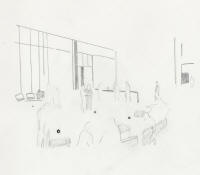
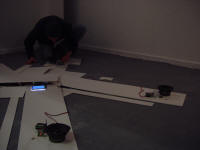
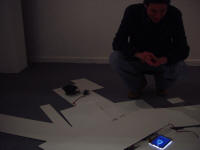
Remediate
Jamie Timms
Media: Wireless network consisting of three
motes, three re-recordable 20second sound modules, three
speakers/microphones, one LCD and DVD, and plastic
Size: Dimensions modifiable
Description
The “content” of any medium is always another
medium.
--Marshall McLuhan, Understanding Media
[W]e call the representation of one medium in another remediation,
and we will argue that remediation is a defining characteristic of
the new digital media. What might seem at first to be an esoteric
practice is so widespread that we can identify a spectrum of
different ways in which digital media remediate their predecessors,
a spectrum depending on the degree of perceived competition or
rivalry between the new media and the old.
--Bolter and Grusin, Remediation
Remediate is a series of works that are
concerned with understanding, through theoretical art practices, the
viral propagation of new media through the remediation of preceding
media.
Remediation in terms of media theory is understood as immediately
depicting or imitating one medium in another. Every medium
remediates other media – preceding ones as well as successive ones.
Viral propagation in wireless networks is used as an analogy in
understanding this.
The only thing new about a new medium is the way it remediates older
media – like the host-parasite interaction of a new virus introduced
through the process of replication, mutation, survival and
competition. For example, while an old virus dies, another survives,
spreading and mutating — for better or worse — through modification.
But modifications of the new media also allow the old media to
infect and remediate and thus stays current – serving as a catalyst
for reproduction and for successful future infections. Like the host
in a host-parasite interaction, technology has become the host that
maintains the media parasite. The host and parasite are in a dynamic
interaction, and the outcome of which depends upon the properties of
the parasite and of the host.
Media is parasitic. Everything we see or hear in one medium is a
reproduction of another medium. All our lives we learn how this
reproduction works, and thus we are able to learn to use and
understand media and its many properties. With this kind of
instinctual knowledge, we are subsequently able to learn to use any
medium, including any new ones that are introduced.
For media artists of the 21st century, UC (Ubiquitous Computing) and
AR (Augmented Reality) offer a remediation for creative-theoretical
and host-parasitic properties. Through viral propagation, motes in
UC and AR applications are media that are fundamentally a
remediation of a previous medium: the virus. On the one hand,
Remediate presents the motes as a metaphor for technology as a host
for the virus of human speech. On the other hand, the motes serve as
a metaphor for the infectious and competitiveness characteristics of
new technologies.
“Language extends and amplifies man but it
also divides his faculties. His collective consciousness or
intuitive awareness is diminished by this technical extension of
consciousness that is speech.”
-- Marshall McLuhan
Remediate, is a work that is infecting new technologies by being the
most effective replicator of creative and theoretical thought. As
technological competitiveness is also becoming ubiquitous, the
possibilities of the most successful technologies are detrimental to
human language.
Virus is a language from outer space.
-- William S. Burroughs
If language is a virus from outer space and the parasite of the
human-host, then perhaps humans are also a virus and the parasite of
the technology-host.
Technical Details
Symptoms: Viral propagation, infection, and
its visualization
Working in a top-down / progressive refinement, the sculpture’s
realization consists of several drafts leading to a refined and
final version.
Early conceptual sketch (not yet attached)
Three MOTES, each with the ability of recording and playing 20
seconds of speech will, upon the introduction of the recorded
material, become infected. This infection is visualized as audible (il)legibillity.
The recorded speech contained within the three sound modules are
triggered randomly by the three motes. And due to the wireless
network traffic, The audible (il)legibillity, will add interesting
complexities to the playback of the recorded speech.
A ten minute DVD of various footage of cell biology will also
accompany the speech component.
PVC plastic will function as the architectural framework, and the
independent pieces allow for modifiable compositions.
Links
http://en.wikipedia.org/wiki/Virus
http://en.wikipedia.org/wiki/Meme
http://en.wikipedia.org/wiki/Self-replication
http://computer.howstuffworks.com/mote.htm
http://www.manovich.net/nnm%20map/Bolter.rtf
http://www.hermans.org/agents2/ch4.htm
|
|
Laugh-O-Meter
Julumarie Joy Cornista
Media: Motes, Computer, Printer, Paint
Size: Belt-2"x2"
Description
Laughing is the individualized sounds of
enjoyment paired with jiggling breaths and involuntary body
movements, especially in the stomach. These instant reactive
movements result when the body falls prey to something funny; for
example, an arm goes up to cover the mouth, a clap with both hands,
leaning back or forward, or even the classic knee slap. Try to pay
attention to this next time there are funnies around. Enjoy the
smiles, weird sounds, and the way your stomach or diaphragm can’t
stay still when you have a good laugh.
My project involves a small mote computer installed into a belt that
measures movements and converts them into numbers in order to rate
how funny things are. As the participant walks up to my
installation, he or she puts on the belt and presses the start
button. This button activates the mote computer inside the belt and
also starts video clips on the monitor. As the viewer watches the
clips, the mote records their movements and prints out a laugh value
that corresponds to each clip. The print-out is an art artifact that
represents your “ha-ha” reactions to specific moments in time. It is
important that the viewer remain still, as the mote measures all
movement. If you were to bend down and tie your shoe, it would be
register on the laugh meter and make the reading inaccurate.
The videos refer to the era of silent films, when physical comedy
ruled the screens. The first video clip shows my friend trying to
jump over a parking meter but missing and hitting himself in the
crotch. Funny? Maybe. In the second clip he finally completes the
jump but almost falls. Was it funnier when he hit himself or when he
makes it over the meter? The third clip is of two women wrestling in
a pool of whipped cream. This is not a classic type of comedy, so
the Laugh-O-Meter will answer the question: Is it even funny at all?
The fourth clip is a continuation of the wrestling match that
involves more physical action such as kicking and spitting whipped
cream in the face. The last clip is a reference to classic physical
comedy: slipping on a banana peel. In the first clip, the actress
falls hard on the floor. The second clip is some “behind the scenes”
banana peel footage.
The purpose of the Laugh-O-Meter is to determine what makes
something funny. Since laughing is an involuntary response it is a
honest way to measure how funny people find different types of
comedic scenarios. Can people ever agree on what is funny? We’ll
have to see.
Technical Details
Links
|
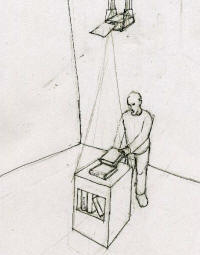
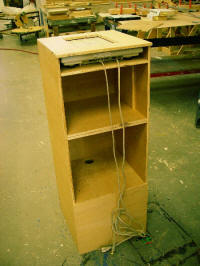
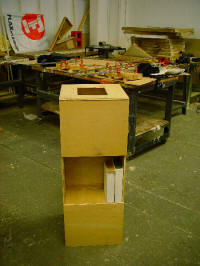
Towers of Babel (beta version)
Sébastien Loghman
Media: Video projection, laptop, scale,
books, wood
Size: Width on the ground: around16 feet / 16 feet. Height of
the structure: as tall as the room
Description
Towers of Babel is an interactive
installation which questions language. Starting with a short
description of a foreign person’s experience in his native language,
the visitor plays with dictionary books of different nationalities
to translate the text and little by little transform it into a new
obscure language. Thus, the translator software used here turns into
some kind of poetry generator that denies meaning to bring new
grammatical forms, new associations of words in an anarchic mix of
languages.
Technical Details
In the center of a room is installed what appears to be a book
shelf on which is projected a text. It contains books the visitor
can use. Their covers are white and on their edges their titles show
they are different languages dictionaries. There are at least two
dictionaries of the same language.
When the visitor places the dictionary under the projection of the
original text, a translation in the book language appears on its
white cover. Then, the visitor can place another dictionary on this
book and translate the translation, etc...
As the visitor stacks the books, he builds his own tower of Babel. A
new language starts to be generated and the meaning of the first
text slightly disappears.
Links
http://users.skynet.be/maevrard/esperanto.htm
http://www.philophil.com/philosophie/echange/analyses/linguistique/Babel.htm
http://www.google.com/language_tools?hl=fr
|
|
